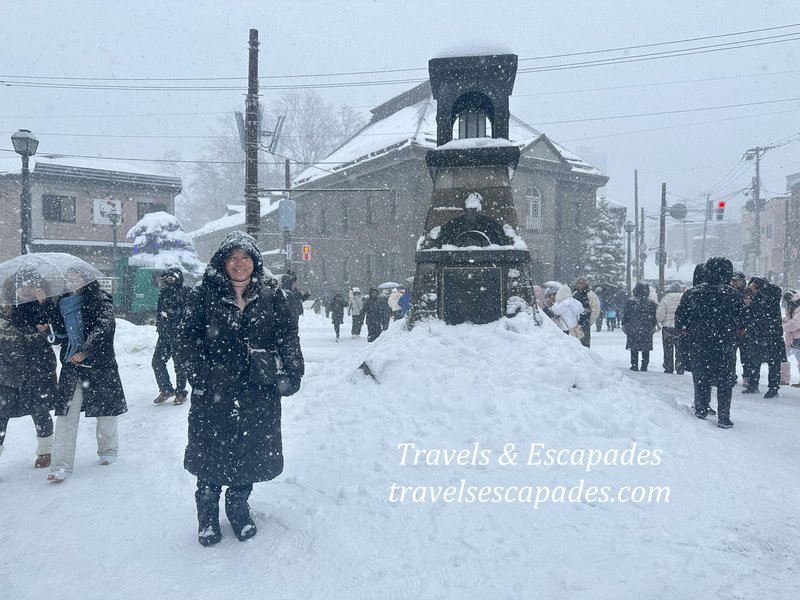
February 28, 2025

A day trip from Sapporo to Otaru is one of the most scenic and convenient short getaways in Hokkaido. The train ride along the coast offers beautiful views of Ishikari Bay, and Otaru is a charming port town rich in history, fresh seafood, and unique cultural attractions.
Getting from Sapporo to Otaru by Train
Train Line: JR Hakodate Main Line (Rapid or Local)
Departure Station: Sapporo Station
Arrival Station: Otaru Station
Duration: 32–45 minutes
Cost: ¥750 (one way)
Frequency: Trains depart every 15–20 minutes
For the best coastal views, be sure to sit on the left side of the train!
During peak hours or busy seasons, you can opt for the Airport Rapid Train to Otaru, which has a few stops along the way. This train ensures a comfortable, guaranteed seat. You can purchase a reserved seat ticket in advance at the JR ticket machine or counter.
Alternatively, you can board the Airport Rapid without a seat reservation, but if all seats are taken, you will need to stand near the door for the duration of the journey.
Otaru is Beautiful Year-Round
Winter (Dec–Feb): Snow-covered canal and the enchanting Otaru Snow Light Path Festival in February.
Spring (Apr–May): Cherry blossoms in nearby parks.
Autumn (Sep–Nov): Stunning red maple leaves lining the streets.
Must-See Attractions in Otaru:
1. The iconic Otaru Canal – a picturesque and historic waterfront area.
2. A leisurely stroll through Sakaimachi Street – known for its preserved merchant houses, shops, and cafes.
3. The charming Otaru Music Box Museum and the beautiful Kitaichi Glass shop, perfect for picking up unique souvenirs.

We traveled from Niseko Hirafu to Sapporo Station by Chuo Bus, departing at 2:39 PM. I managed to take a nap during the ride and woke up when the bus crew announced a stopover for 15 minutes. It was 4 PM then. The rest stop had clean toilets, and we grabbed hot chocolate and fries before continuing the journey. Another hour and a half later, we finally arrived at our destination.
The last stop was right across from Sapporo Station. Our hotel, Keio Prelia Hotel, was just two blocks away. After checking in, we set out to find a place for dinner. We returned to Sapporo Station, headed to Stellar Place, and took the elevator to the 6th floor, which is home to a variety of restaurants.

Stellar Place at Sapporo Station – The 6th floor is home to a vibrant restaurant floor featuring a variety of dining options, including Japanese cuisine, sushi, ramen, and international dishes.
For dinner, we chose a restaurant specializing in tempura and soba. The meal was delicious and satisfying, with a total cost of ¥3,490.
For dinner, we chose a restaurant specializing in tempura and soba. The meal was delicious and satisfying, with a total cost of ¥3,490.

From our room, we had a clear view of the Seico Mart, located at the corner of Tarukawa-dori Avenue and Kita 8Jo-dori. The road was blanketed in snow, which had been falling steadily since we left Niseko. Unlike Niseko, where snow accumulates mostly on walkways, the roads here, used by vehicles, were also covered in snow. However, there were a few areas free of snow, particularly around establishments.
These snow-free areas are a result of underground heating systems funded by the building and store owners. These systems help keep the pavement clear during winter. In many parts of Sapporo and other snow-prone regions, these underground heating systems are installed to prevent snow accumulation on roads and walkways. The systems typically consist of pipes or cables embedded beneath the pavement that circulate warm water or electric heat, keeping the surface temperature above freezing. As a result, the snow melts upon contact with these heated surfaces, leaving areas clear of snow even while the surrounding roads remain covered.

On Day 2 in Sapporo, we set off for Otaru. At the Sapporo station gates, we simply tapped our Digital Apple Suica to pass through.
The Digital Apple Suica is a contactless IC card used for convenient transportation and shopping throughout Japan. Integrated with the Apple Wallet on iPhone and Apple Watch, it allows for seamless travel without the need for a physical card.
Key Features of Apple Suica:
• *Works for trains, buses, and shopping at convenience stores, vending machines, and restaurants.
• Just tap your iPhone or Apple Watch at Suica-compatible readers.
• Add Suica to Apple Wallet via the Suica app or directly from the Wallet app.
• You can also transfer a physical Suica card to your iPhone.
• Recharge via Apple Pay or at Suica ticket machines and convenience stores.
• No need for a Japanese bank account—Apple Pay with international credit cards works.
• Works even when your phone is offline or out of battery (on iPhone XS or later).
• Unlike a physical Suica, which requires a 500 yen deposit, Apple Suica does not.*
Where Can You Use Apple Suica?
• JR trains, subways, buses across Japan.
• Convenience stores (7-Eleven, FamilyMart), vending machines, taxis, and restaurants.
How to Add Suica to Apple Wallet?
1. Open the Wallet app on your iPhone.
2. Tap “+” and select Suica.
3. Choose to create a new card or transfer an existing physical Suica.
4. Add funds using Apple Pay or another payment method.
Good to Know:
• If you leave Japan, you can still use Suica in Apple Wallet for future trips.
• You can refund your balance via the Suica app, but refunds might be subject to fees.
• Apple Suica works with Express Mode, meaning no need to unlock your iPhone when tapping.
Suica and PASMO stay active for 6 months. If not used for 6 months the card is temporarily deactivated but can be re-activated by any station staff or by adding money to the card in Wallet. If not used for 10 years the card is deactivated but the balance can be refunded to a JP bank account.

At Sapporo Station, there are two train lines that go to Otaru. The faster option is the Rapid Airport train, which makes only a few stops and reaches Otaru in about 30 minutes. The local train, on the other hand, stops at all stations along the route and takes nearly an hour to reach Otaru.
Otaru, a charming port city in Hokkaido, Japan, is renowned for its picturesque canal, historic buildings, and fresh seafood.
Otaru, a charming port city in Hokkaido, Japan, is renowned for its picturesque canal, historic buildings, and fresh seafood.

On our way to Otaru by train from Sapporo, we were amazed by the vast expanse of snow covering the roads. The winter landscape was truly picturesque, with snow blanketing the fields, trees, and roadsides. It was a stark reminder of Hokkaido's famous heavy snowfall, which transforms the region into a winter wonderland during the colder months.

When we arrived in Otaru, the platform was completely covered in snow. The snow gave the station a peaceful, wintery feel, adding to Otaru's charm as a picturesque port town. The cold, crisp air and snow-covered surroundings made us excited to explore the city.

The Otaru Station has a retro European-style design, reflecting the city’s history. The station’s architecture features large windows and detailed facades, giving it an old-world charm. This style is a reminder of Otaru’s past as a busy port city where Western influences shaped its buildings and culture. The design adds to the nostalgic feel of the town, especially with the snowy surroundings.

We visited the famous Otaru Canal Promenade and enjoyed the snowy scenery. Some paths were slippery, so we had to be cautious as we walked along the canal, but the winter atmosphere made the experience even more magical.
The Otaru Canal Promenade is a historic waterfront built in 1923 to support Otaru’s port trade. Preserved in the 1980s, it is now a scenic walkway lined with old warehouses, gas lamps, and cafés. The canal is especially beautiful in winter, transforming into a winter wonderland with snow-covered rooftops and glowing lanterns. Many tourists play in the snow, build snow sculptures, and enjoy the magical atmosphere, especially during the Otaru Snow Light Path Festival. It remains one of Otaru’s most iconic and romantic destinations.

We had fun playing in the snow—lying down, sitting, and making the most of the winter wonderland around us. It was a joyful, carefree moment, fully immersing ourselves in the snowy landscape.



The Otaru Canal does not freeze in winter due to a combination of factors, including the relatively mild temperatures around the canal, the presence of flowing water, and efforts to maintain the canal.
Flowing Water: The canal has continuous flowing water, which prevents it from freezing. Water in motion is less likely to freeze compared to still water, as the movement disrupts the formation of ice.
Temperature: While Hokkaido experiences cold winters, the temperature around the canal is generally not low enough for a prolonged period to cause the water to freeze. Additionally, the presence of nearby structures and buildings may provide some shelter from the cold winds.
Maintenance: The canal is a popular tourist attraction, so local authorities may take measures to ensure it remains ice-free for aesthetic and practical purposes. This includes measures like heating systems or active monitoring of the area during the winter months.
As a result, despite the cold and snow around the canal in winter, it remains unfrozen and continues to flow, creating a picturesque winter scene.

We continued walking through the snow toward the Otaru Music Box Museum, following the charming Sakaimachi Street. As we walked, the snowfall grew heavier, and soon, we found ourselves covered in a blanket of snow, adding to the magical atmosphere of the day.
Sakaimachi Street in Otaru is a charming area known for its preserved merchant buildings, many of which have been transformed into museums, restaurants, and unique shops. Here are some of the notable spots along this historic street:
Museums:
1. Otaru Music Box Museum:
A renowned museum showcasing an extensive collection of music boxes, both antique and contemporary. Visitors can enjoy the melodies and even purchase music boxes as souvenirs.
2. Kitaichi Venetian Art Museum:
•Dedicated to Venetian glass art, this museum displays intricate glassware, clothing, and furniture, offering a glimpse into Venetian craftsmanship.*
Restaurants and Cafés
LeTAO:
Famous for its double fromage cheesecake, LeTAO offers a delightful selection of pastries and desserts. The café provides a cozy atmosphere to enjoy sweet treats.
Kamaei:
Specializing in kamaboko (fish cakes), Kamaei offers freshly made fish cakes in various flavors. It’s a great spot to experience a traditional Japanese snack.
Otaru Beer Hall:
Housed in a historic building, this beer hall serves locally brewed beers alongside a menu of hearty dishes, making it a perfect place to relax.
Other Notable Attractions:
Kitaichi Glass:
A renowned glassware shop where visitors can admire and purchase beautifully crafted glass items. Some locations offer workshops to create personalized glass pieces.
Marchen Square:
A picturesque intersection featuring a charming steam clock and surrounded by European-style architecture, making it a popular photo spot.
Otaru Orgel Doh:
Another notable music box shop offering a wide variety of music boxes and related souvenirs, housed in a historic building.

Just across from the Otaru Music Box Museum, you'll find Marchen Square, a quaint little plaza that captures the charm of Otaru’s historic atmosphere. The square is often adorned with festive decorations and features a whimsical, fairy-tale-like ambiance, making it a perfect spot for photos. Its name, "Marchen," meaning "fairy tale" in German, reflects the magical feel of the area.
Nearby, the Hello Kitty Café is another fun stop for fans of the iconic character. This cozy café offers a menu filled with cute, Hello Kitty-themed treats, including cakes, drinks, and desserts, all designed with the beloved character in mind.

We had late lunch at Wagyu Kurosawa. We ordered the Wagyu Sukiyaki set, Prawn tempura and Snow crab tempura with a total cost of ¥14,630

Going back to Sapporo, we wanted to take the rapid airport that could take us to Sapporo from Otaru in 35 minutes. It was announced fully sold out for today.

Since the Rapid Airport tickets sell out quickly, I purchased a reserved seat and the fare for tomorrow’s journey from Sapporo to New Chitose Airport. A total of ¥3,980 was charged to my card.
For the return trip, we took the local line from Otaru to Sapporo. The train was already waiting when we boarded at 4:45 p.m., with a scheduled departure time of 5:05 p.m., heading toward Ebetsu via Sapporo. We arrived at Sapporo Station at 5:56 p.m.
For the return trip, we took the local line from Otaru to Sapporo. The train was already waiting when we boarded at 4:45 p.m., with a scheduled departure time of 5:05 p.m., heading toward Ebetsu via Sapporo. We arrived at Sapporo Station at 5:56 p.m.

We had a reservation at a Yakiniku restaurant near our hotel for 8:30 p.m., but when we arrived at Sapporo Station, we decided to switch plans and opted for seafood pasta instead. The food court, where we found this delicious meal, is located on the 6th floor of Stellar Place in the south wing.

On our last day in Hokkaido, our train to New Chitose Airport was scheduled for 8:38 a.m. We woke up at 6 a.m. and had an early breakfast at the hotel. After checking out at 7:45 a.m., we set off for Sapporo Station. Dragging our heavy luggage through the thick snow proved to be quite a challenge. It was exhausting, and I had to stop a few times to catch my breath. On top of the weight of our bags, we also had to worry about slipping on the icy ground. Despite these obstacles, we reached the station in 15 minutes.

Once inside the station, we inserted the ticket I had purchased the day before at the Otaru counter. The ticket popped out on the other side, and I made sure to pick it up—it's important not to forget it, as you might need it for ticket inspections or to show proof of your reserved seat during the journey.
You can board the Rapid Airport Train even without a seat reservation. There is a designated car for unreserved seats, or you can opt for the reserved seat area, standing by the door if all the seats are taken. It's a closed-off space, so you won’t disturb passengers with reservations. The train arrived at the domestic departure area of the airport, and after exiting the train, we passed through the gantry. In our case, we inserted the ticket to get through.
You can board the Rapid Airport Train even without a seat reservation. There is a designated car for unreserved seats, or you can opt for the reserved seat area, standing by the door if all the seats are taken. It's a closed-off space, so you won’t disturb passengers with reservations. The train arrived at the domestic departure area of the airport, and after exiting the train, we passed through the gantry. In our case, we inserted the ticket to get through.

At the platform, while waiting for our scheduled train, it was quite crowded. According to our ticket, we were supposed to board the Airport 38 train, departing at 8:48 a.m. The train arrived about 5 minutes before the scheduled time. Our seats were near the door, but a bit far from the luggage rack, which was located further back. Only one piece of luggage could fit in our space, so my husband's luggage was placed by the door, in the area where passengers without seat reservations were standing. The train took us to the domestic departure area. Upon exiting the train station, we passed through the gantry, where we inserted our ticket to get through.

Handling baggage drop is always a challenge. We each had one luggage, both weighing over 23kg, so we couldn’t use the kiosk. We had to wait in line for assistance. Our allowance was two bags, each up to 23kg, but the kiosk isn’t advanced enough to process bags that exceed the weight limit, even if the ticket allows for two bags.
At the airport, I took the opportunity to buy some Hokkaido goodies to bring back to Singapore.
At the airport, I took the opportunity to buy some Hokkaido goodies to bring back to Singapore.

Our flight from Sapporo to Haneda was delayed by 20 minutes due to heavy snow, as they needed extra time to clear the taxiway. We began to worry, as we had a scheduled airport transfer bus at 3:30 p.m. We arrived at Haneda at 2:30 p.m., and once again, waiting for our luggage proved challenging. It took about half an hour to collect our bags.
Outside the airport, the airport limousine buses and other buses were neatly organized at the exit. Each bus stop was manned by staff, and when your bus arrived, the staff would collect your luggage and store it in the trunk. A tag number would be provided for identification.
And with that, our Hokkaido escapades come to an end. Next stop: Tokyo Disneyland! See you there!
Check out related posts:
Snowy Niseko Escapades in Hokkaido, Japan
Updated on March 3, 2025
Outside the airport, the airport limousine buses and other buses were neatly organized at the exit. Each bus stop was manned by staff, and when your bus arrived, the staff would collect your luggage and store it in the trunk. A tag number would be provided for identification.
And with that, our Hokkaido escapades come to an end. Next stop: Tokyo Disneyland! See you there!
Check out related posts:
Snowy Niseko Escapades in Hokkaido, Japan
Login to add comment
 24
24
 24
24
Views: 23760

